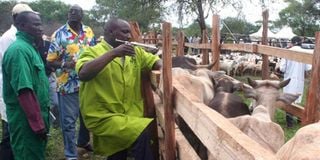Livestock diseases to look out for

A veterinary officer vaccinates cattle at Kinna livestock market in Garbatulla during a livestock vaccination exercise to mark the eradication of rinderpest.
What you need to know:
- Rinderpest is more deadly than FMD and even more trade-sensitive.
- Kenya should, after eradicating rinderpest, have embarked on strict FMD control, aiming at attaining an FMD-free status with vaccination
Last week, I discussed how Kenya can rid herself of the burden of foot and mouth disease (FMD) of cattle, sheep, goats and pigs.
The disease is trade-sensitive. It is a hindrance to trade in livestock as well as their products. It reduces farmers to paupers fast.
Some readers have since said I was being economical with the truth because FMD is not the only disease burdening Kenyan farmers and the animal economy.
I agree but my article looked at one disease that is considered a menace globally.
If a country can tame FMD to eradication or FMD-free status with vaccination, it would be much easier to control or eradicate other diseases.
Rinderpest is more deadly than FMD and even more trade-sensitive.
When the programme for rinderpest eradication was in high gear, FMD was being controlled with vaccination but there was little hype about it.
The reason was that priority was eradication of rinderpest. No benefit would have accrued from FMD-free status if rinderpest was still rampant.
The good news is that Kenya, among other countries, was eventually declared free of rinderpest without vaccination. For that reason, the country no longer vaccinates for the disease.
Kenya should, after eradicating rinderpest, have embarked on strict FMD control, aiming at attaining an FMD-free status with vaccination. The experience with rinderpest eradication would have made it much easier to achieve the objective.
Unfortunately, the disease control operations broke down especially after the World Bank-prescribed structural adjustment programmes, which saw the country privatise veterinary services without a clearly defined delivery and regulatory framework.
The gains that had been made on FMD control were lost. Fortunately, rinderpest has not re-emerged.
The nation’s biggest hindrance to trade in livestock and livestock products is FMD. The country must make a conscious decision to address FMD in a well-structured programme.
The other illnesses that need to be addressed with FMD, with a view to eradicating them, are lumpy skin disease (LSD), black quarter and anthrax (BQA), contagious bovine pleuropneumonia (CBPP) and Rift Valley fever (RVF).
LSD is a viral disease of cattle caused by the lumpy skin disease pox virus. It is spread mainly by mosquitoes and possibly biting flies. The disease causes heavy swelling of raised nodules all over the animal’s skin and the mucous membranes of the gastro-intestinal, respiratory and reproductive tracts. Animals with no previous exposure to the disease through vaccination, natural infection or maternal immunity get severe illness that may even cause death.
In addition to animal deaths, LSD causes loss in production, veterinary cost, spoilage of the hide and poor body condition for survivors.
BQA are two bacterial diseases that mainly cause sudden death. The diseases are not common and tend to be present in some areas, especially wet regions or areas carcasses of infected animals have been buried or left to rot on the surface.
The diseases often do not give any chance for treatment because the bacteria produce potent toxins that kill animals without warning. Usually the farmers report to the doctor they either found the animals dead or the animal just staggered and dropped dead.
Both diseases are zoonotic; meaning that they can be transmitted to humans. Black quarter causes tissue death of heavy muscles with foul smelling gas called fulminant human gas gangrene. It sets in rapidly and may cause death if not treated early.
Anthrax causes vomiting, bleeding, stomach pains, headache, skin wounds and death. Lives are saved if the disease is treated early. Sudden death is not normally seen in people because human patients are able to sense the signs, present themselves for medical help and explain their symptoms to healthworkers.
RVF is caused by the Rift Valley fever virus transmitted by mosquitoes. It causes high fever, bleeding in tissues, destruction of the liver and death in livestock. It occurs manly in times of heavy rains and water logging because mosquito eggs infected with the virus require exposure to prolonged moisture in order to hatch.
It is advised that cattle, sheep, goats and camels in areas known to be RVF hotspots be vaccinated against RVF before the onset of heavy rains like the El Nino predicted for this year. RVF is also zoonotic.
Outbreaks have occurred in Kenya with the 1997 one being most devastating and widespread.
Humans are infected with yellow fever through mosquito bites and coming into contact with blood and body fluids from infected animals.
The good thing is that the six diseases are very effectively controlled in livestock through vaccination. Kenya produces the six vaccines locally at the Kenya Veterinary Vaccines Production Institute (KEVEVAPI) as Footvax, lumpivax, blanthrax, Riftvax and Contavax.
KEVEVAPI is the only vaccine-producing centre of its type and magnitude in East Africa. The country is therefore well-placed to produce and deliver vaccines for the control of these six livestock diseases.
It is important to note that while FMD is highly trade-sensitive, a country would still not carry out serious global trade in livestock and livestock products without controlling the six diseases. Except for black quarter, the others are on the global watch list. Trade must be halted when there are outbreaks.
Save for CBPP, FMD and LSD, the other three diseases are zoonotic.
The onus is on farmers, animal health service providers and livestock industry decision-makers to make use of the vaccines to rid Kenya of the disease burden. This would enhance the economy and livelihoods.





